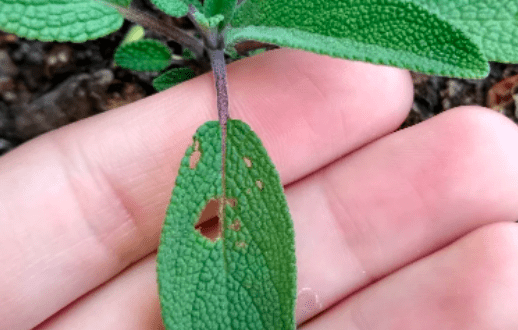Sage plants are a popular addition to any garden, but sometimes those lovely leaves can start to look a bit off. If you’re noticing small holes in your sage leaves, don’t worry – you’re not alone. This blog post will explore the possible causes of this issue and offer some solutions. Keep reading to learn more!
Why Are There Holes in My Sage Plant Leaves?
There are holes in your sage plant leaves because a pest is eating them. The most likely culprits are caterpillars, leafhoppers, and aphids, but there are a few other pests that could be to blame.
These pests love to munch on sage leaves because they’re full of nutrients. While a few holes here and there won’t kill your plant, a heavy infestation can cause serious damage. Not to mention, it’s just not very pleasant to look at!
If you’re not sure which pest is responsible, take a close look at the damage. Caterpillars typically eat leaves from the edges, while aphids and leafhoppers tend to go for the softest, most delicate parts of the leaves.
Look closely and see if you can spot any of these pests on your plant. If so, take action to get rid of them (more on that below).
How to Treat Sage Plant Leaves with Holes?
To treat sage plant leaves with holes, you’ll need to get rid of the pests that are causing the damage. Big pests could be picked off by hand, but most likely you’ll need to resort to pesticides.
My favorite method of pest control is to use neem oil (Amazon link), which is an organic, all-natural pesticide. Simply mix it with water according to the instructions on the bottle, and then spray it directly onto your plant.
If you have a serious infestation, you may need to treat your plant more than once. Be sure to follow the instructions on the neem oil carefully, and always err on the side of caution – it’s better to be safe than sorry!
Once the pests are gone, your sage leaves should start to heal. Give them a little time and they’ll be back to their old selves in no time.

How to Keep Pests Away From Sage Plant Leaves?
To prevent holes in sage plant leaves, it’s important to take some preventive measures. First, make sure your garden or houseplants are healthy. Pests are more likely to attack weak or sickly plants, so give your sage a little extra TLC.
Second, keep an eye out for early signs of trouble. Check your plant regularly for pests, and take action as soon as you see any. The sooner you catch a problem, the easier it will be to deal with.
Finally, keep the area clean and free of debris. Pests love places to hide, so tidy up any potential hiding spots in your garden. This will make it harder for them to set up shop and start munching on your sage leaves!
What Else Causes Holes in Sage Plant Leaves?
There are a few other reasons why your sage plant leaves might have holes:
Disease
One possibility is that the damage is caused by a disease, such as powdery mildew or leaf spot.
If you think this might be the case, take a close look at the affected leaves. If they’re covered in a powdery substance or have dark spots, it’s likely that a disease is to blame.
To treat a diseased plant, you’ll need to use a fungicide. Again, neem oil is a great option, but there are plenty of other products on the market. Just be sure to follow the instructions carefully.
Animals
Another possibility is that the holes were caused by animals, such as rabbits or deer. These creatures love to munch on tender leaves, and they’re not picky about what kind of plant they eat.
If you live in an area with a lot of wildlife, it’s a good idea to take some preventive measures. You can protect your plants with a fence or netting, or you can try using a repellent. There are many different types of repellents on the market, so experiment until you find one that works for you.
Should I Prune Sage Plant Leaves with Holes?
There is no need to prune sage plant leaves with holes. The damage is usually not severe enough to warrant pruning, and the leaves will eventually heal on their own.
In fact, pruning can actually do more harm than good, as it removes vital foliage from your plant. If you do decide to prune, only remove the absolutely necessary leaves – don’t go overboard!
The only time I would recommend pruning is if a fungal disease is to blame for the holes. In this case, it’s best to remove the affected leaves to prevent the disease from spreading.
Pruning is also a good option if you want to tidy up your plant. If the holes are unsightly, you can snip them off and give your sage a neater appearance. Just be sure not to remove too much foliage, or you’ll stress out your plant.
Conclusion
Holes in sage plant leaves are a common problem, but there’s no need to panic. In most cases, the damage is minor and can be easily fixed. By taking some preventive measures and being vigilant about pests, you can keep your sage plants healthy and hole-free.
Thanks for reading! I hope this was helpful. If you have any questions or comments, please feel free to leave them below. Happy gardening!
Tim is an avid gardener from the UK. He was the founder of PlantCarer.com from 2021 to Sep 2023. He sold PlantCarer.com to Aaron. He has since started his own business called Seed To Supper, which provides new gardeners all the materials you need in a box (pots, seeds, compost and instructions) to grow your own delicious and nutritious vegetables and herbs from start to finish – no garden required.










0 Comments